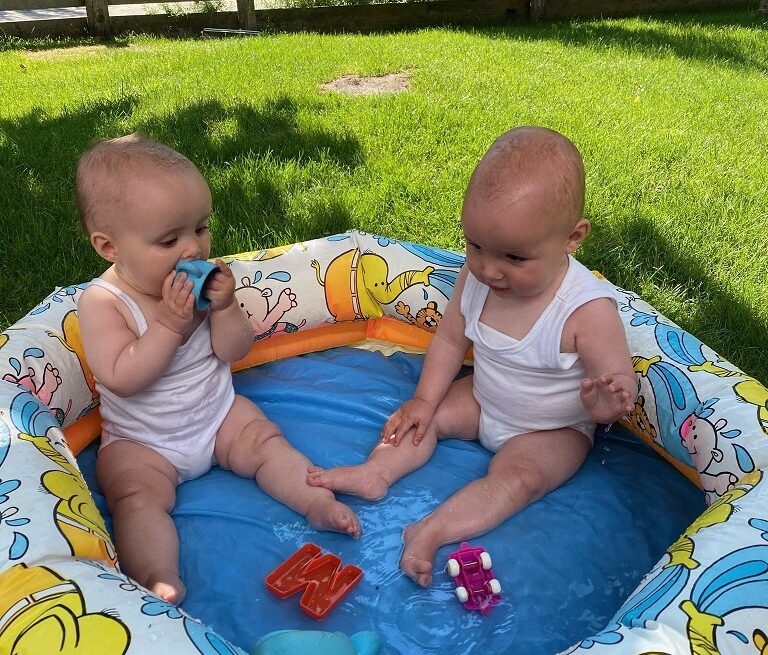When there is a summer temperature and it is or becomes higher than 25°C indoors and/or outdoors, we take the following measures:
- The blinds go down before the sun shines in.
- We turn on as few lights as possible.
- Fans are turned on when the indoor temperature exceeds 25°C.
- Windows and doors are opened wide when it is cooling.
- We provide shade on the playground.
- The children can stay outside if it is cooler there than inside (we avoid exposure to direct sunlight between noon and 3 p.m. because the sun is very bright then).
- Children can drink extra and we don’t wait for thirsty children.
- In extreme heat, the duration of outdoor play is limited.
Use of air conditioning:
The advice from the GGD nurse is to keep the temperature in the groups at a maximum of 24 to 25 degrees Celsius, even during a heat wave. There is always a good sense of what the temperature is doing to the children and staff.
The difference of up to 5 degrees between indoor and outdoor temperatures is not realistic during a heat wave. We try to maintain 24 to 25 degrees Celsius in the groups even then.
In the bedrooms, the air conditioning is not on when children are sleeping. We turn the air conditioner on immediately upon entering in the morning, with door ajar and in between when no children are sleeping.
Grease, clothes, wardrobe!
Babies and children have fragile skin. Their body’s own protective mechanisms are not yet fully developed, making them more likely to burn than adults. It is incredibly important to ensure proper sun protection. Therefore, we have listed all the info and tips on sun protection for you.
Grease!
When should you lubricate? Anytime vulnerable skin is exposed to the sun. Not only when you go to the beach for a day, but also when you go hiking or biking. Even then, children catch a lot of sunlight unnoticed, even when it is cloudy. So make it a habit to lubricate your child.
Lubricating every two hours is really a must. You should definitely not apply too thinly; the protection factor will go down. As a guideline, keep at least 7 teaspoons per lubrication session. Use 1 teaspoon of cream for face and neck, 2 for arms and shoulders, 2 for chest, abdomen and back, and 2 for legs and feet.
Clothes are the ideal protection!
Protecting your child properly from the sun goes beyond just putting on sunscreen. A hat or cap and UV-resistant clothes are an added protection. UV-resistant clothing is the ideal extra protection:
- It protects with a high factor even when the clothing gets wet;
- It dries quickly and is breathable;
- You can rinse it out easily, which is more difficult with cotton shirts.
Repel! Stay out of the sun regularly.
Sun strength is highest between noon and 3 p.m. In high sunlight, the skin burns faster than you think. Therefore, it is good to seek shade during those hours. In the shade, the sun’s power is lower.
Yet you can also burn in the shade, such as under an umbrella. Note! Not all parasols are made of UV-resistant material. So if you think you’re fine out of the sun, keep track of when sunscreen was last applied.
Tips.
- For children, use sunscreen with a protection factor of at least 30;
- Repeat lubrication every 2 hours. Also re-lubricate when your child gets out of the water, has dried off or has played and sweated;
- Is oiling up a challenge? Make rubbing in a game. Put dots on arms, legs or face and let your child connect the dots;
- Always keep babies out of full sun. Stay out of the sun between 12 and 3, even if children are properly sunscreened. Sun strength is highest then. Sun strength in the Netherlands is between 4 and 7 during the summer months. From sun strength 7 to 8, the skin burns after only ten minutes;
- Choose a shady spot to eat or eat inside between noon and 3 p.m;
- Trees, umbrellas or shade cloths, for example, are perfect for shade;
- Keep children under 1 year of age completely out of direct sun.
Grease, clothes and weather! Children see how you handle sun protection. Therefore, lead by example!


